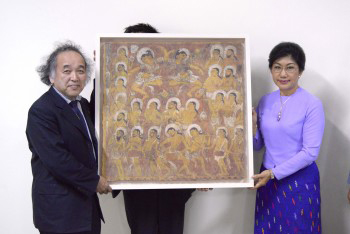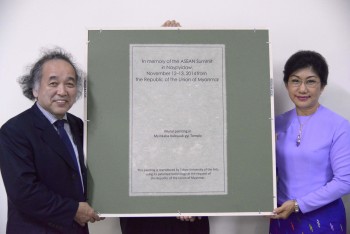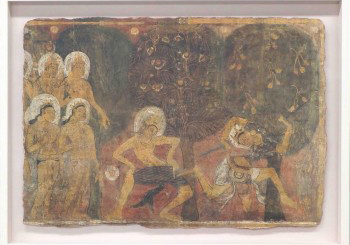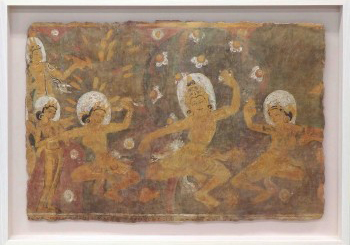Presentation of Bagan Temples Mural Reproductions to the Myanmar Ministry of Culture
2014.11.12 | ALL
Left : MIYASAKO Masaaki , Professor Tokyo Univercity of Arts
On November 5th, 2014, in Naypyidaw; the capital of the Republic of the Union of Myanmar (hereafter “Myanmar”), Professor Miyasako Masaaki from the Graduate School of Fine Arts donated 25 mural reproductions (three types) of the Bagan Temples*, produced at the request of the Myanmar Ministry of Culture, to the Deputy Minister for Culture, Daw Sanda Khin.
The mural reproductions are to be presented as mementoes by the government of Myanmar to the leaders of the various ASEAN (Association of Southeast Asian Nations) and 3 nations, including Prime Minister Shinzō Abe, at the 2014 ASEAN Summit to be held in Naypyidaw from November 12 to13.
This development came as part of a global cultural diplomacy project that has rapidly progressed since the beginning of October, through consensus building initiatives between the University and Myanmar Ministry of Culture.
When Professor Miyasako introduced the university’s unique patented technology for reproducing cultural assets (Patent No. 4559524, July 30, 2010) and presented samples manufactured using the technology, representatives from the Myanmar Ministry of culture expressed a keen interest and made an official request for Tokyo University of the Arts to produce reproductions of the Bagan Temple murals. The technology enables artists to create murals of the same quality as the original works.
After conducting a series of negotiations with the Ministry, Professor Miyasako began reproducing the murals using high-definition digital data and 3D measurement data obtained during a field survey in the Bagan Archaeological Zone. A team of university members succeeded in efficiently reproducing a total of 25 murals of three types for the Ministry.
This year will mark the 60th anniversary of the establishment of diplomatic relations between Japan and Myanmar. The President of Tokyo University of the Arts, Miyata Ryōhei, sent a letter to the President of Myanmar in which he acknowledged the strengthening relationship between the two nations and the art and cultural exchanges, in addition to the political and economic aspects, which were necessary for deepening the mutual understanding of citizens. The letter also stated that President Miyata wished to use the opportunity to contribute to the prosperity of art culture throughout Asia and that he was committed to the continued friendship between Japan and Myanmar.
Using Professor Miyasako’s donation of the mural reproductions as a foothold, the university will pursue further cooperative relations with Myanmar, with respect to the production of murals for a model temple due to be exhibited in the National Museum. This temple is under construction in the capital city of Naypyidaw. Several other temples are planned for the Bagan Archaeological Zone. An exchange of personnel between the Myanmar National University of Arts and Culture and Tokyo University of the Arts is part of the initiative.
Based on global collaborations, the development of new education and research activities and art culture exchange is expected in the future.
* The Bagan Temples are regarded as one of the three greatest Buddhist sites in the world, along with Angkor Wat in Cambodia and Borobudur in Indonesia. Given their unique character, the temples are important as cultural assets in terms of history and architecture.
Almost all of the scattered pagodas and temples were constructed between the 11th and 13th centuries and are of various sizes and colors. It is believed that there are more than 3,000 pagodas and the remains of the wall and ceiling murals drawn inside the pagoda and temple have a high artistic value and are different from the Buddhist art that developed through the Silk Road.
However, the majority of the murals have been badly damaged by looting, theft, and natural disasters, and there are, as yet, no current plans to restore them.











